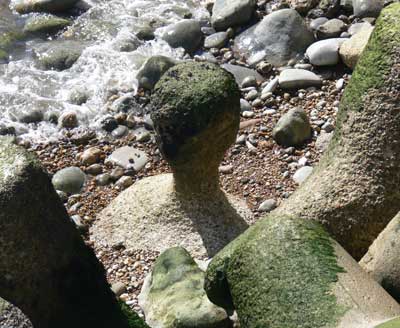Tetrapods: the concrete Canutes?
- Complaining about the Mainland - 17th August, 2024
- New island designation – is it just greenwash? - 26th April, 2024
- Police and Crime Commissioners – a solution or a problem? - 21st April, 2024
Down at the sea-wall the giants have been playing Jacks:

These are tetrapods: giant four-pointed concrete structures popular in the 1970s and 1980s for sea defence. First invented in France in 1950, a huge number of variations now exist. Although in the UK they are now out of vogue, they can still be seen at many coastal locations, where their strange, jumbled structure, defiantly un-natural in appearance, has the feel of an art installation. Elsewhere in the world their popularity remains undiminished. In Pacific countries and Japan particularly the tetrapod is a mainstay of coastal engineering: by 1993, 55 percent of the entire coast of Japan had been altered by concrete in one form or another, including any of the many different shapes and sizes of tetrapod manufactured there. But do they work, and are they worth it? Tetrapods are made of concrete, and the advance of concrete technology has enabled bigger and more complex structures to be built. These tetrapods from the Isle of Wight are marked with their date of manufacture and a serial number – this was number seventeen on the 2nd October 1980.

Tetrapods often carry some sort of identification number, and it has been suggested that this is to aid satellite monitoring. This isn’t likely to be the case, as in most cases such numbers wouldn’t be visible from satellite imagery, and in any case many of these (for example those pictured) predate the public use of such technology. It’s possible that the numbers can identify a batch in case of problems – or most likely engineers just can’t help themselves but put numbers on things. In Japan the tetrapod is still a more than familiar site on the complex coast of the island nation. 21-year-old art student Kobori Motohiro is an avid fan of tetrapods:

I think the attraction of tetrapods lies in their contrast with nature. The material of a tetrapod is concrete and its shape is formal, which can’t be found in nature. Also, it is manufactured by pouring concrete into molds. The tetrapod is a symbol of artificiality. Setting hundreds of tetrapods on a big scale that matches that of nature is simply art… I heard that tetrapods are occasionally criticized because they destroy the scenery; however, I think this shows that people can’t ignore the power of tetrapods as’objects’.
But not everyone in Japan is so keen. From a peak in 1993, coastal armouring is now used less, and in some cases has been removed. The Japanese government claims to have begun removing some concrete in pursuit of an utsukushii kuni (beautiful nation) policy launched by the Ministry of Land, Infrastructure and Transport, and aimed at reducing armouring on designated coasts. In 2004, the government started to remove wave-dissipating blocks from nine coastal areas to preserve more of Japan’s coastal scenic beauty. And of course, like all coastal defence, even the tetrapods are only a temporary measure that is merely delaying the inevitable…



Hi,
Can you send me the sample dimensions of tetrapod? I suggest to have a volume of 8Tons. Can you please help me to construct in the auto cad for my reference.
Thank you.
More Power.
I’ve got no idea how to make these things. Sorry.
It always is nice to see different products made from concrete. Nice post, look forward to more!